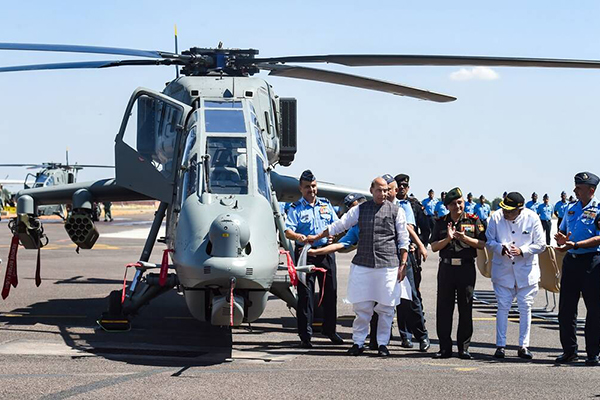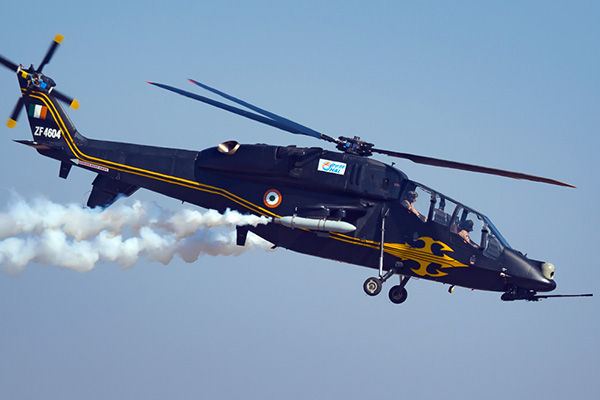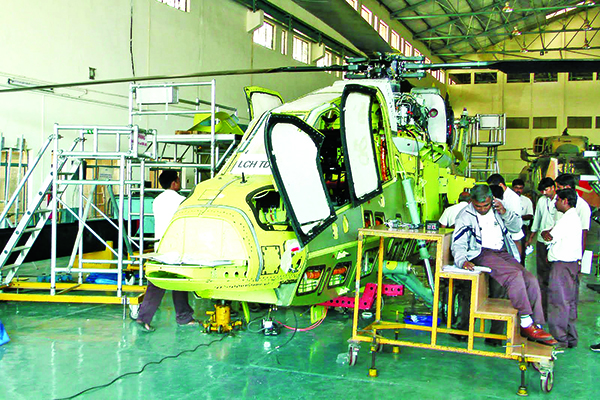
Focus Now on Indian Multi Role Helicopter
The indigenous Light Combat Helicopter (LCH), capable of destroying enemy air defence, conducting counter insurgency strikes and much more, was formally inducted into the Indian Air Force (IAF) at the Jodhpur air base on 3 October. The fleet of four helicopters was inducted at a ceremony in presence of Defence Minister Rajnath Singh, Chief of Air Staff Air Chief Marshal VR Chaudhari and other senior military officials. The helicopter will be called ‘Prachand’, which means fierce.
The HAL designed and manufactured LCH has been inducted in the Jodhpur-based 143 Helicopter Unit of the IAF.
The LCH is the only attack helicopter in the world which can land and take off at an altitude of 5,000 meters with a considerable load of weapons and fuel, meeting the specific requirements laid out by the Indian Armed Forces.
Ownership of Attack Helicopters
The Army and the Air Force have fought over the ownership of attack helicopters since the venerable Mi-25 Akbar was first inducted into the IAF in 1984 and again when the AH-64 Apache was purchased. It appears that the IAF and the Army have settled for duality of ownership. The orders placed for Prachanda are testimony to this duality. Of the 15 LCH sanctioned by the CCS on 30 March 2022, ten of them were for the IAF and five for the Army.
Features of the Light Combat Helicopter
LCH has the maximum take-off weight of 5.8 tonnes, maximum speed of 268 kilometers per hour, range of 550 kilometers, endurance of over three hours and service ceiling — the maximum density altitude to which it can fly — of 6.5 kilometres.
The helicopter uses radar-absorbing material to lower radar signature and has a significantly crash-proof structure and landing gear. A pressurised cabin offers protection from nuclear, biological and chemical (NBC) contingencies.
The helicopter is equipped with a countermeasure dispensing system that protects it from enemy radars or infrared seekers of the enemy missiles. As far as weapons systems are concerned, a 20 mm turret gun, 70 mm rockets and air-to-air missile systems are onboard.
LCH is powered by two French-origin Shakti engines manufactured by the HAL.
With these features, the LCH has the capabilities of combat roles such as destruction of enemy air defence, counter insurgency warfare, combat search and rescue, anti-tank, and counter surface force operations.
The LCH is also armed with a 20 mm nose gun and 70 mm rockets, which are not guided ones.
The LCH is designed to have systems in place to minimise external kinetic and electronic threats.
The LCH, which has a combat radius of 500 km and a service ceiling of a whopping 21,000 ft, is designed with stealth features such as reduced visual, aural, radar and infrared (IR) signatures and crashworthiness features for better survivability.
The LCH has advanced features like helmet-mounted sights, forward-looking infra-red suppression systems, flares and chaff, and glass cockpits. It is also equipped with self-sealing fuel tanks, bullet-proof windshields, and damage-tolerant main rotor blades to withstand small arms fire.
Integration of Weapons Suite
Work is still in progress and weapon systems will be integrated soon. For the present, the LCH lacks its main arsenal and protection suites for now and will take time to be fully operational.
The attack helicopter — also known as tank buster — will get its anti-tank guided missile (ATGM) only by mid-2023 and while it is integrated with air-to-air missile launchers, the missile has not been ordered yet.
The ATGM intended to be integrated with Prachand is the indigenous Helina, whose air force version is called Dhruvastra. The testing of Helina/Dhruvastra, made by DRDO, is currently on and that it will be integrated on the LCH by mid-next year as the plan is to fast track the process.
While the helicopter comes integrated with the European air-to-air missile Mistral 2 launchers, manufactured by the MBDA, the missiles have not been ordered yet. With a minimum range of 500 m, Mistral can take down airborne targets of up to 6.5 km.
The LCH is yet to get the electronic warfare suite unlike the weaponised version of Advanced Light Helicopter ‘Rudra’ which comes with Saab’s Integrated Defensive Aids Suite (IDAS). The IDAS system was first integrated with the Army and Air Force’s version of ALH Dhruv in 2005. With radar warning receivers supported by the missile and laser warning, IDAS allows the aircraft’s sensors to detect radar missile and laser threats from any position relative to the aircraft. Once a hostile target is detected, the system selects a semi or completely automated response with countermeasures dispensing to fool the incoming projectile or the radar. The plan was to have an indigenous system on board the LCH designed by DRDO, but it is a work in progress.
Genesis of the Light Combat Helicopter
It was during the 1999 Kargil war that the need was first felt for a homegrown lightweight assault helicopter that could hold precision strikes in all Indian battlefield scenarios. This meant a craft that could operate in very hot deserts and also in very cold high altitudes, in counter-insurgency scenarios to full-scale battle conditions.
India has been operating sub 3 ton category French-origin legacy helicopters, Chetak and Cheetah, made in India by the HAL. These single engine machines were, primarily, utility helicopters. Indian forces also operate the Lancer, an armed version of Cheetah. In addition, the Indian Air Force currently operates the Russian origin Mi-17 and its variants Mi-17 IV and Mi-17 V5, with maximum take off weight of 13 tonnes, which are to be phased out starting 2028.

But the requirement was for a more agile, multi-role dedicated attack helicopter. After the initial deliberations, the government sanctioned the LCH project in October 2006, and HAL was tasked to develop it. The HAL’s Rotary Wing Research and Development Centre, which had already worked on the Advanced Light Helicopter (ALH) Dhruva and its weaponised version ALH Rudra, embarked upon the project.
Development of Light Combat Helicopter
The LCH has been designed as a twin-engine, dedicated combat helicopter of 5.8-ton class, thus categorised as light. It features a narrow fuselage and tandem — one behind the other — configuration for pilot and co-pilot. The copilot is also the Weapon Systems Operator (WSO). While LCH inherits many features of the ALH, it mainly differs in tandem cockpit configuration, making it sleeker. It also has many more state-of-art systems that make it a dedicated attack helicopter.
In the LCH’s journey towards clearance and induction by the IAF and the Army, extensive flight testing has been carried out on four prototypes, also known as Technology Demonstrators (TDs).
The first Technology Demonstrator was completed in February 2010 and took its first flight on March 29 the same year. TD-2 prototype, completed around 2012, successfully passed the cold weather trials at high altitude. TD-3 and TD-4 prototypes, completed around 2014 and 2015, successfully tested other flight test requirements.
The flight testing was carried out at various altitudes, from sea level to the Siachen range, in extreme cold and hot weather conditions, and in desert regions. During these tests, integration of mission sensors such as electro-optical system, helmet-mounted display system, solid state data and video recorder, and weapon systems such as turret gun, rockets and air-to-air missile systems was carried out. Weapon firing trials were also completed. The four prototypes have together undergone over 2,000 flights with close to 1600 flight hours.
Initial operational clearance came in 2017 for the IAF variant and in 2019 for the Army variant. In August 2020, the MoD added LCH to the items under import embargo. In November 2021, Prime Minister Narendra Modi symbolically handed over the LCH to the Indian Air Force, paving the way for its final induction.
In March 2022, the Cabinet Committee on Security (CCS) approved procurement of 15 LCH Limited Series Production (LSP) — 10 for IAF and five for Army — at the cost of Rs 3,887 crore along with infrastructure sanctions worth Rs 377 crore.
The 15 copters are the initial lot and the orders will go up once the systems are in place. It is estimated that the Army will go in for nearly 90 of them for its aviation arm to support ground operations, while the IAF will have a little less.
Indigenous Content
One consequence of the Russian war in Ukraine is that it has brought into sharper focus the extent of India’s dependency on Moscow for defence hardware, and the urgent need for indigenisation to the extent possible. The LCH is 45 per cent indigenous right now, but will become more Indian in the years to come.
In March, the Ministry of Defence identified 18 major platforms for “make in India” and the 2022-23 defence budget reflects this with an allocation of 25 per cent of the defence research and development for Indian industry-led efforts in this direction. HAL’s indigenous multi-role helicopter, being developed to take the place of Mi17s that have started to be phased out, is the next big challenge.
Will there be a demand for India-made defence helicopters? It is hard to say, but the logic of self-reliance in defence production demands international standards. The LCH is a great start.
The Road Ahead
Eventually, the Army is looking for another 95 LCH and the IAF another 65 of them. After receiving a contract for the LSP in March, some units have already been delivered and the rest are at various stages of acceptance. HAL has said that it has drawn a detailed masterplan for achieving the peak rate production capacity of 30 helicopters per year in order to produce the remaining 145 LCHs in eight years from the date of signing of Series Production order.
The Army Aviation has three Brigades at Leh, Missamari and Jodhpur, and operates around 145 indigenous Advanced Light Helicopters (ALH), 75 of which are the Rudra weaponised variants, and around 190 ageing Cheetah, Chetak and Cheetal helicopters. Another 25 ALH Mk-III are on order which will be inducted within two years. The Army will also start receiving the Apache attack helicopters in early 2024, six of which have been contracted under an estimated $800 million deal from the Boeing in February 2020. In addition, the Army is also pushing a case for 11 more Apaches for which negotiations are under way.
The focus is now on the development of medium-lift category Indian Multi Role Helicopter (IMRH), to replace the fleets of IAF’s workhorse Mi-17 and other helicopters which will start phasing out over the coming decade.
HAL has so far rolled out three indigenously designed and developed helicopters in the light category (below 10 ton) – the 5-ton class Advanced Light Helicopter (ALH) Dhruv, its weaponised version ALH Rudra, and the LCH. It has also developed a 3-ton class Light Utility Helicopter (LUH), primarily as a replacement for the French origin legacy helicopters Chetak and Cheetah. So the next logical step is a Made-in-India medium lift helicopter in the 13-ton category – the IMRH.
On April 2, speaking at a function to mark 60 years of service of Chetak helicopters, Defence Minister Rajnath Singh emphasised the need to develop the IMRH which, he said, is a significant requirement for the armed forces and has a huge market potential.
He also pushed for fast-tracking the development of helicopter technology, saying this will not only be a key strategic asset in the defence sector, but will also make India a dominant force in the global helicopter market.
The Navy operates close to 60 helicopters like Kamov and Seaking and the newly inducted MH-60R in medium lift category. Its projected requirement over the next few years is close to 120. A large share of this requirement may be fulfilled by the IMRH.


















